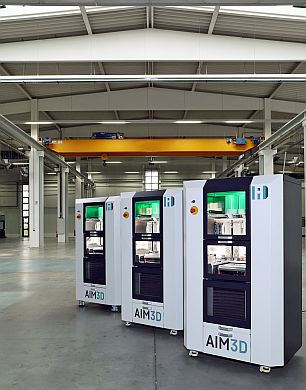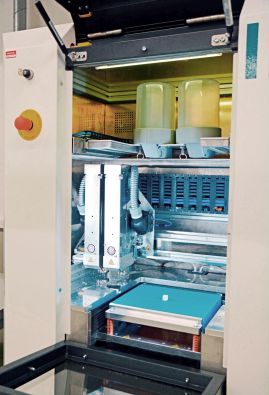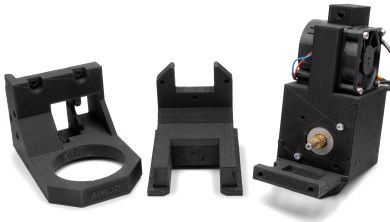3D Printer Can Save Up to 96% in Material Costs
AIM3D GmbH, based in Rostock, Germany, offers patented 3D printers in two build area classes: the ExAM 255 and ExAM 510. These multi-material 3D printers work according to the fused granulate modelling principle (FGM).

Multi-material 3D printer ExAM 255
Fused granulate modelling (FGM) is an additive manufacturing process that is based on the widely-used thermoplastic melt layer process (FDM/FFF) and thus belongs to the material extrusion group (MEX), and to the fused granulate fabrication subgroup (pellet-MEX).
The FGM print head processes pellets into a thin melt thread and applies it to the build area. Thanks to the automatic generation of support material, more complex shapes can also be realized, enabling custom-made production or the use of prototype production in injection moulding technology.
The special feature of this process approach is the inexpensive basic material: in contrast to the common melt layer processes, such as fused filament fabrication (FFF), FGM does not use a complex filament, but commercially available, mass-produced, certified thermoplastic injection molding pellets.
VIDEO: AIM3D -- ExAM 255
The material cost savings for a processed component is between 80 and 96%, depending on the material group.
Features of a 3D CEM Extruder
The hardened nozzle of a CEM extruder made of special steel enables a high output of up to 250 cm³/h. It can be changed quickly and is designed for easy maintenance. This is important when using very abrasive materials such as polymers reinforced with metals. glass fiber or ceramics. A 3D CEM printer using polymer pellets enables build rates of 2 to 20 times higher speed (kg/h) compared to filament printers.
Process Chain
The feedstock for CEM production is metal/ceramic powder plus thermoplastic binder components which are premixed as polymer pellets in the 3D printer. The component print process then takes place. If metal/ceramics are processed, a so-called green part is created, which must be debound before being turned into a brown part in the sintering unit.

Build area of an ExAM 255 machine with two pellet extruders
Sintering is the final post-processing to create a bond between the metal particles in the component and to increase its density, resulting in the finished metal part. Of course, compensation for volume shrinkage during the process chain has to be considered.
Variety of Materials and Material Properties
The unique selling point of a 3D CEM printer is the variety of materials that comes with the ability to process polymers, metals and ceramics on a universal 3D printing system. This can also be supplemented by combining processes (hybrid components) or with material combinations (multi-component technology).
The same or comparable properties to injection moulding such as thermal conductivity, media resistance, damping, mechanical properties, shrinkage or density can be achieved through the use of identical, certified material instead of filaments. In addition, the processing of long fiber-reinforced materials with fiber lengths of up to 3 mm is possible with a filling level of up to 60%. This means enormous advantages for 3D printing, since polyamide applications are very widespread and 3D CEM printers offer a reasonably-priced 3D process for these applications.

3D components made of polyamide PA6 GF30
A 3D CEM printer therefore achieves not only high densities but also high tensile strengths.
For a polyamide (PA6 GF30), tensile strengths of 110 -180 MPa are achieved with classic injection molding applications. A 3D CEM printer such as the ExAM 510 can achieve tensile strengths of almost 140 MPa. The latest development is the voxelfill principle: chambers in the component are selectively filled in a checker-board pattern to overcome inhomogeneous strengths in 3D printing. The more homogeneous tensile strengths that are thus achieved are therefore unique to 3D printers.
Conclusion
The CEM process with a 3D multi-material printer opens up a wide range of applications from small series (AM) to medium-sized series production of up to 100,000 parts/year and complements powder injection molding (PIM) or conventional injection molding through preliminary prototype production. The use of certified pellets, metal and ceramic powder offers, in addition to unit cost advantages, an ideal strategy from prototypes to starting series production.
Want more information? Click below.
Rate this article
View our terms of use and privacy policy ::m::